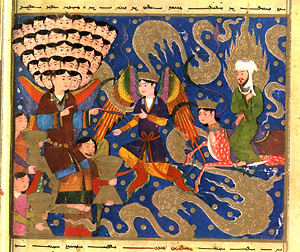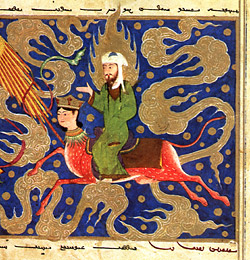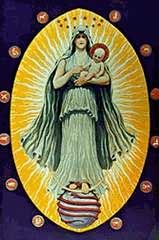The Revelation of The Lord God Jesus Christ
The Book of
THE APOCALYPSE OF ST. JOHN THE APOSTLE AND EVANGELIST
{WHO IS THE LAST PROPHET OF THE BIBLE UNTIL SAINT ENOCH AND SAINT ELIJAH RETURN AT THE CONSUMMATION OF DAYS – Muhammad is a prophet of God, Allah (SWT), but his Holy Scripture that God gave him to preach is the Qur’an}
The Apocalypse is a revelation of things that were, are and will be. We are actually witnessing some of the events foretold in this book, but many still lie in the future. It is Christ who commands John to write to the seven churches, opens the seven seals, reveals the sufferings of the saints, opens the little book, overcomes the beast, reigns during the period of the first resurrection, judges the dead, both great and small, according to their works at His Second Coming, rules over all things from the beginning, presides over all the changing scenes of earth’s history, and is the King of kings and Lord of lords.
The book presents Christ as the Coming One; it reveals the dealings of Him who came, and who is to come. It opens with the solemn hope that the Coming One will come soon, and closes with the impressive prediction that the Coming One will come quickly.
The book is one of hope, but also one of warning; its aim is to assure the Church of the advent of her Lord in victory. The precise time of this victory lies hidden with God, but it is certain, although the crown will not be won without a struggle. Heaven will be stormed and carried away through suffering and conflict. And all who keep the words of this book will take part in the conflict and share in the victory.The conflict is presented under the form of symbols. It is not easy to give a full interpretation of all the types, but the general symbols are not difficult to understand.
John has arranged the scenes in a sevenfold structure; even in the subordinate visions he keeps to this arrangement. Commentators, however, are not agreed in marking off the limits of each structure.
The book was written in Greek by
Note on parallel passages and commentary. The parallel passages are based on the full concordance thereof relating to, from the Council of Trent; the commentary is late 1940’s Catholic from the full consensus of the Church Fathers on the seven within seven structure of the book.
Also note that the book at the same time “opens from the middle” so to speak. Just like a megilloth (Hebrew for scroll). The first eleven chapters (1 – 11) which culminate in the general judgement – Rev. 11:18 – 19
And the nations were angry: and thy wrath is come. And the time of the dead, that they should be judged and that thou shouldest render reward to thy servants the prophets and the saints, and to them that fear thy name, little and great: and shouldest destroy them who have corrupted the earth.
And the
And the second eleven chapters (12 – 22) which culminate in the general judgement (Rev. 20:11 – 14) and the New Heaven and New Earth (Rev. 21, 22)
Both the first and second eleven chapters begin from the time of Christ’s Incarnation but include the fact that He is Immortal and the Creator of Heaven and Earth. See: Rev. 1:4 – 6 John to the seven churches which are in
And from Jesus Christ, who is the faithful witness, the first begotten of the dead and the prince of the kings of the earth, who hath loved us and washed us from our sins in his own blood (when He became Incarnate by the Holy Spirit and the blessed virgin Mary and went to the Cross for our salvation)
And hath made us a kingdom, and priests to God and his Father. To him be glory and empire for ever and ever. Amen.(DRV)
And see: Rev. 12:1, 2, 5
And a great sign appeared in heaven: A woman clothed with the sun, and the moon under her feet, and on her head a crown of twelve stars. And being with child, she cried travailing in birth: and was in pain to be delivered.
And she brought forth a man child, who was to rule all nations with an iron rod (Christ’s Incarnation). And her son was taken up to God and to his throne (Christ’s Resurrection and Ascension). (DRV)
And see: Rev.:21:6:
6 And he said to me: It is done. I am Alpha and Omega: the Beginning and the End. To him that thirsteth, I will give of the fountain of the water of life, freely. (DRV)
These two phrases that is and that was and that is to come (Greek “‘o oon kai ‘o en kai ‘o erchoumenos”) and I am Alpha and Omega (Greek: “egoo eimi to Alpha kai to Omega”) are emphatic declarations of Christ’s Divinity and Immortality for it is the Thrice Holy Trinity – Rv:4:8 And the four living creatures had each of them six wings: and round about and within they are full of eyes. And they rested not day and night, saying: Holy, Holy, Holy, Lord God Almighty, who was and who is and who is to come. (Greek “‘agious ‘agious ‘agious kurios ‘o theos ‘o pantocrator”) – alone Who possesses Aseity (self existence and Who is therefore alone uncreated) and Who is Immortal of the same Essence/Substance – Nature.
In the above: the “who [that] is”, in Greek “‘o oon”, is the declaration of Aseity. The “who [that] was” and the “who [that] is to come” with the “‘o oon”, self existence, is the declaration of Immortality (having no beginning and no end – always existing). The phrase I am Alpha and Omega has exactly the same meaning. “I am” – “egoo eimi” is the equivalent of Yahweh (God’s proper name) in Hebrew meaning “I am” in the same sense as the above “‘o oon”. Alpha and Omega has the same meaning as Immortality in the above. Pantocrator (translated as Almighty) is the declaration of the Thrice Holy Lord God’s All ruling absolute Sovereignty and includes emphatically the meaning that He is alone uncreated and Creator, ex nihilo, of all of creation. This relates directly to the beginning of the Gospel of St. John and the beginning of the first book of the Torah (the Pentateuch) which is Genesis. See: Genesis 1:1 through 2:4 and
Note on parallel passage notation – the ! after a scriptural reference means that is the emphasis or central point for explanation of the passage.
Then see: The Apocalypse, the Book of the Revelation










 More generally speaking Muslims are reminded in the Koran that humans can experience and speak about God only in symbols. Everything in the world is a sign (aya) of God; so women can also be a revelation of the divine. Ibn al-Arabi argued that humans have a duty to create theophanies for themselves, by means of the creative imagination that pierces the imperfect exterior of mundane reality and glimpses the divine within. The faculty of imagination is commonly associated with the Divine Feminine.
More generally speaking Muslims are reminded in the Koran that humans can experience and speak about God only in symbols. Everything in the world is a sign (aya) of God; so women can also be a revelation of the divine. Ibn al-Arabi argued that humans have a duty to create theophanies for themselves, by means of the creative imagination that pierces the imperfect exterior of mundane reality and glimpses the divine within. The faculty of imagination is commonly associated with the Divine Feminine.
 As is the case with Jesus Christ himself, the godman's parents, Joseph and Mary, never appear in the contemporary historical record of the time they allegedly existed. Nor are they mentioned in non-gospel Christian writings earlier than the purported time of Church father Ignatius (d. 107 CE). Oddly enough, the Islamic sacred text, the Koran, places Jesus and Mary in the same era asMoses, or the 13th century BCE. Arabs believed that Jesus was Joshua, the Old Testament prophet, and that Joshua's mother was "Mirzam," the Miriam of Exodus, sister of Moses and Aaron. (Robertson, CM, 297) In this regard, Joshua is Jesus in Greek, and both Mirzam and Miriam are equivalent to Mariam or Mary. As Strong's Concordance(Gk. 3137) relates: "Mary or Miriam='their rebellion.'" The Persians likewise believed that Joshua's mother was the Mosaic Miriam. Hence, according to Near Eastern tradition there appeared a Jesus, son of Mary, over a thousand years prior to the Christian era. Moreover, like Jesus, who was called "Emmanuel" (Mt. 1:23), a "Persian title of 'the god Immani,' or E-mani,' venerated in Elam as a sacred king-martyr," the Persian savior Mani was said to have been "born of a virgin named Mary." (Walker, 428)
As is the case with Jesus Christ himself, the godman's parents, Joseph and Mary, never appear in the contemporary historical record of the time they allegedly existed. Nor are they mentioned in non-gospel Christian writings earlier than the purported time of Church father Ignatius (d. 107 CE). Oddly enough, the Islamic sacred text, the Koran, places Jesus and Mary in the same era asMoses, or the 13th century BCE. Arabs believed that Jesus was Joshua, the Old Testament prophet, and that Joshua's mother was "Mirzam," the Miriam of Exodus, sister of Moses and Aaron. (Robertson, CM, 297) In this regard, Joshua is Jesus in Greek, and both Mirzam and Miriam are equivalent to Mariam or Mary. As Strong's Concordance(Gk. 3137) relates: "Mary or Miriam='their rebellion.'" The Persians likewise believed that Joshua's mother was the Mosaic Miriam. Hence, according to Near Eastern tradition there appeared a Jesus, son of Mary, over a thousand years prior to the Christian era. Moreover, like Jesus, who was called "Emmanuel" (Mt. 1:23), a "Persian title of 'the god Immani,' or E-mani,' venerated in Elam as a sacred king-martyr," the Persian savior Mani was said to have been "born of a virgin named Mary." (Walker, 428) As it turns out, the Virgin Mary is, like Jesus Christ, a mythical character, founded upon older goddesses. Following on the heels of goddesses such as Aphrodite, Astarte, Cybele, Demeter, Hathor, Inanna, Ishtar and Isis, Mary is "both virgin and mother, and, like many of them, she gives birth to a half-human, half-divine child, who dies and is reborn." (Baring, 548) Regarding the Great Mother Goddess, upon whom Mary is based and whose names are legion, in Forerunners and Rivals of Christianity (II, 45) Francis Legge says:
As it turns out, the Virgin Mary is, like Jesus Christ, a mythical character, founded upon older goddesses. Following on the heels of goddesses such as Aphrodite, Astarte, Cybele, Demeter, Hathor, Inanna, Ishtar and Isis, Mary is "both virgin and mother, and, like many of them, she gives birth to a half-human, half-divine child, who dies and is reborn." (Baring, 548) Regarding the Great Mother Goddess, upon whom Mary is based and whose names are legion, in Forerunners and Rivals of Christianity (II, 45) Francis Legge says: impregnated Danae in a shower of gold; and the child was Perseus…
impregnated Danae in a shower of gold; and the child was Perseus… 
 …while the story of
…while the story of  Also a product of a virgin birth, the Indian avatar Buddha's conception is portrayed as coming to his mother, Maya, in a dream, similar to the conflicting gospel tales of Joseph's dream or the angel appearing to Mary. Regarding Buddha, in Christianity Before Christ (87) Dr. John Jackson states:
Also a product of a virgin birth, the Indian avatar Buddha's conception is portrayed as coming to his mother, Maya, in a dream, similar to the conflicting gospel tales of Joseph's dream or the angel appearing to Mary. Regarding Buddha, in Christianity Before Christ (87) Dr. John Jackson states:
 "The Virgin Mary is called not only the Mother of God, but the Queen of Heaven. This connects her directly withastronomic lore. The ornamentation of many continental churches often includes a representation of the Sun and Moon "in conjunction," the Moon being therein emblematical of the Virgin and Child….
"The Virgin Mary is called not only the Mother of God, but the Queen of Heaven. This connects her directly withastronomic lore. The ornamentation of many continental churches often includes a representation of the Sun and Moon "in conjunction," the Moon being therein emblematical of the Virgin and Child…. two gods, the sun and the moon, were primeval and eternal; and they called the former Osiris, the latter Isis, assigning each of these names according to some relevant characteristic…
two gods, the sun and the moon, were primeval and eternal; and they called the former Osiris, the latter Isis, assigning each of these names according to some relevant characteristic… The ritual of the nativity, as it appears to have been celebrated in Syria and Egypt, was remarkable. The celebrants retired into certain inner shrines, from which at midnight they issued with a loud cry, "The Virgin has brought forth! The light is waxing!" The Egyptians even represented the new-born sun by the image of an infant which on his birthday, the winter solstice, they brought forth and exhibited to his worshippers. No doubt the Virgin who thus conceived and bore a son on the twenty-fifth of December was the great Oriental goddess whom the Semites called the Heavenly Virgin or simply the Heavenly Goddess…
The ritual of the nativity, as it appears to have been celebrated in Syria and Egypt, was remarkable. The celebrants retired into certain inner shrines, from which at midnight they issued with a loud cry, "The Virgin has brought forth! The light is waxing!" The Egyptians even represented the new-born sun by the image of an infant which on his birthday, the winter solstice, they brought forth and exhibited to his worshippers. No doubt the Virgin who thus conceived and bore a son on the twenty-fifth of December was the great Oriental goddess whom the Semites called the Heavenly Virgin or simply the Heavenly Goddess… While the masses have been kept in the dark, the knowledgeable elite have been aware of what the Virgin truly represents, even as they have attempted sophistically to explain "her" relationship to the "earthly" life of "our Lord." Concerning the astrotheological nature of the gospel story, including the virgin birth/immaculate conception, the famous Christian theologian and saint Albertus Magnus, or
While the masses have been kept in the dark, the knowledgeable elite have been aware of what the Virgin truly represents, even as they have attempted sophistically to explain "her" relationship to the "earthly" life of "our Lord." Concerning the astrotheological nature of the gospel story, including the virgin birth/immaculate conception, the famous Christian theologian and saint Albertus Magnus, or  Another example of the ancient astrotheology appears in the observance of the "Assumption of the Virgin," celebrated in Catholicism on August 15th, when the Virgin Mary was "assumed" or "taken up." The observance is not representative of an actual event that happened to an historical character but commemorates the time when the constellation of the Virgin is "rendered invisible by the solar rays." (Higgins, 6) In other words, the summer sun's brightness blots out Virgo. Mary's Nativity, observed on September 8th, occurs when the constellation is visible again.
Another example of the ancient astrotheology appears in the observance of the "Assumption of the Virgin," celebrated in Catholicism on August 15th, when the Virgin Mary was "assumed" or "taken up." The observance is not representative of an actual event that happened to an historical character but commemorates the time when the constellation of the Virgin is "rendered invisible by the solar rays." (Higgins, 6) In other words, the summer sun's brightness blots out Virgo. Mary's Nativity, observed on September 8th, occurs when the constellation is visible again. As is evident, the worship of the Virgin Isis was eventually and nearly seamlessly transformed into that of the Virgin Mary:
As is evident, the worship of the Virgin Isis was eventually and nearly seamlessly transformed into that of the Virgin Mary: